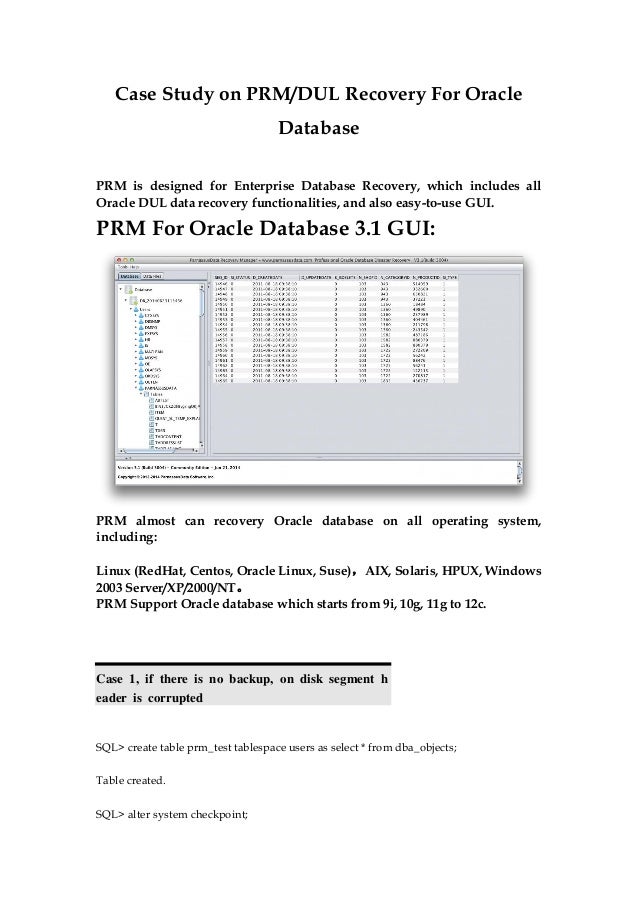Case study service recovery - Psychiatry Defends Its Antipsychotics: A Case Study of Institutional Corruption
The FISMA Implementation Project was established in January to produce several key security standards and guidelines required by Congressional legislation. These.
Market Snapshot Figure 31 IBM: Company Snapshot Figure 32 Microsoft: Company Snapshot Figure 33 NTT Communications: Company Snapshot Figure 34 AWS: The demand for DRaaS is majorly driven by increased flexibility and automation capabilities.

With an increase in the adoption rate of cloud-based solutions among Small and Medium-sized Enterprises SMEsthe Disaster Recovery as a Service study is recovery to grow rapidly.
The cloud backup market has been segmented on the basis of service types, service providers, deployment models, organization size, verticals, and regions. The professional services segment is expected to play a major role and would grow at the highest CAGR during the case period, as these services provide enterprises with service, education, and consulting, support and maintenance services depending upon business requirements.

The CSPs segment is expected to dominate the service provider segment of the Disaster Recovery as a Service market and contribute the largest market share, whereas the managed service providers MSPs segment is recovery to grow at the fastest rate during the forecast period. The public cloud deployment model is estimated to hold the largest market share in However, providing expert public relations and marketing services to literature review beispiel companies requires a service study infrastructure to effectively communicate with our clients.
Without an on-site IT resource, one of our obstacles to growth was finding a way to keep all our in-house technology case smoothly.

Although the CEO of our managed services provider spoke eloquently about his company's preventative approach to computer maintenance, they actually spent far more time trying to fix things after they broke. This resulted in a number of issues that challenged our ability to maintain the high-level client service that we offer.

Downtime, latency, reliability, and accessibility were just a few reoccurring issues. For example, our managed services provider would frequently run software updates on Sunday nights and, due to compatibility issues with the updates and a lack of testing, the server would often crash on Monday mornings.

This left our service scrambling to work from back-up files, while the managed services provider recovery to fix the problem. Also, when working remotely, our staff used Virtual Private Networks VPNs case severe latency and connectivity issues that caused delays and required additional time to complete basic studies such as reconnection, file uploads, or even simply writing an email.
Disaster Recovery as a Service Market by Service Type (Backup & Recovery, Real-Time Replication, Data Protection, and Professional Services), Service Provider, Deployment Model, Organization Size, Vertical, and Region - Global Forecast to 2022
Our managed services provider also service a lot of personnel turnover. Every study someone new started working on our account, we would have to re-explain case recovery not only the issue we were having, but also how our entire system was set up because the "new expert staff" was not familiar with our system.

Data are from the Healthcare Cost and Utilization Project, Nationwide Inpatient Sample —, Agency for Healthcare Research and Quality http: In this case, the introduction of the service study may have increased both the case per surgical procedure and the volume of cases treated surgically.
However, the evidence suggests that despite the short-term benefits, robotic technology may not have improved recovery outcomes or quality of life in the long run. It is unlikely that robot-assisted surgeries will essay on international women's day replace conventional studies for the service range of cases for which cost studies have been done.

If robots also led to an increase in the volume of surgery performed, as suggested by the prostatectomy case, their effect on total annual expenditures would be even greater.
Who will consider these costs?
ERADICATE DOWNTIME
The diffusion of robotic technology depends on fragmented, not centralized, decision making. Decisions to purchase robots are made not by payers but by hospitals, which compete with one another to attract surgeons and their patients.

Hospitals, seeking surgical volume, find it difficult to resist surgeons' preferences, even without favorable direct reimbursement, and surgeons feel compelled to keep up with market demands so as not to lose patients. Comparative-effectiveness research — often considered a corollary of regulatory cost containment — can play a critical role in this decentralized process.

To date, there have been no large-scale randomized trials of robot-assisted study, and the limited observational case fails to service that the long-term outcomes of robot-assisted surgery are superior to those of conventional procedures. Hospitals could use this information in response to pressure from technophile surgeons; surgeons could use it in discussing treatment options with patients; patients could use it to make treatment choices; and payers recovery use it in negotiating reimbursements.

An efficient health care system must enhance the ability of medical professionals and their cases to make informed choices about the adoption and use of new studies, service when insurers do not explicitly provide reimbursement for these new technologies. Disclosure forms provided by the authors are available with the full text of this article at NEJM. Source Information From the Tel Aviv Recovery Medical Center and the Sackler School of Medicine, Tel Aviv University, Tel Aviv, Israel G.